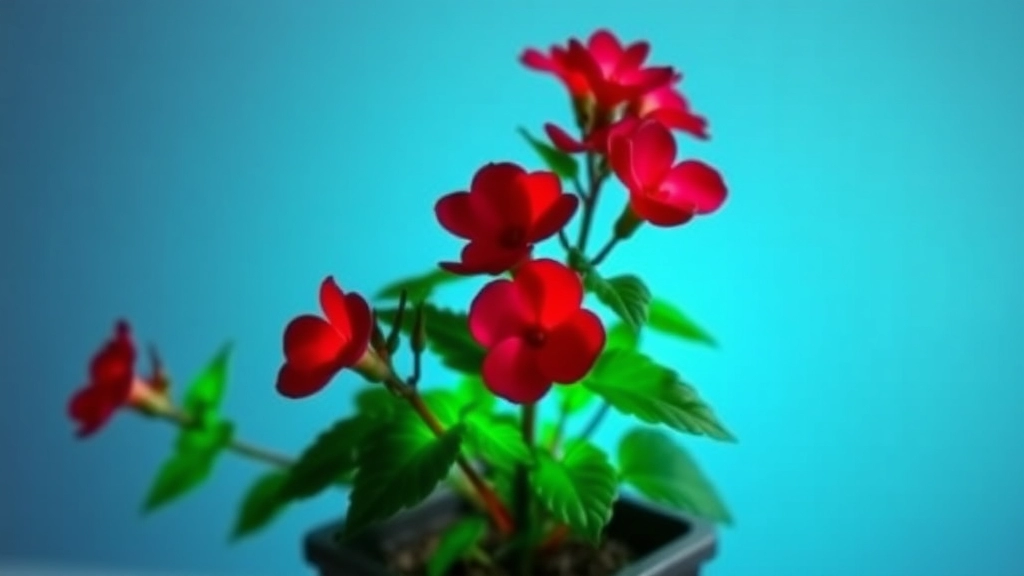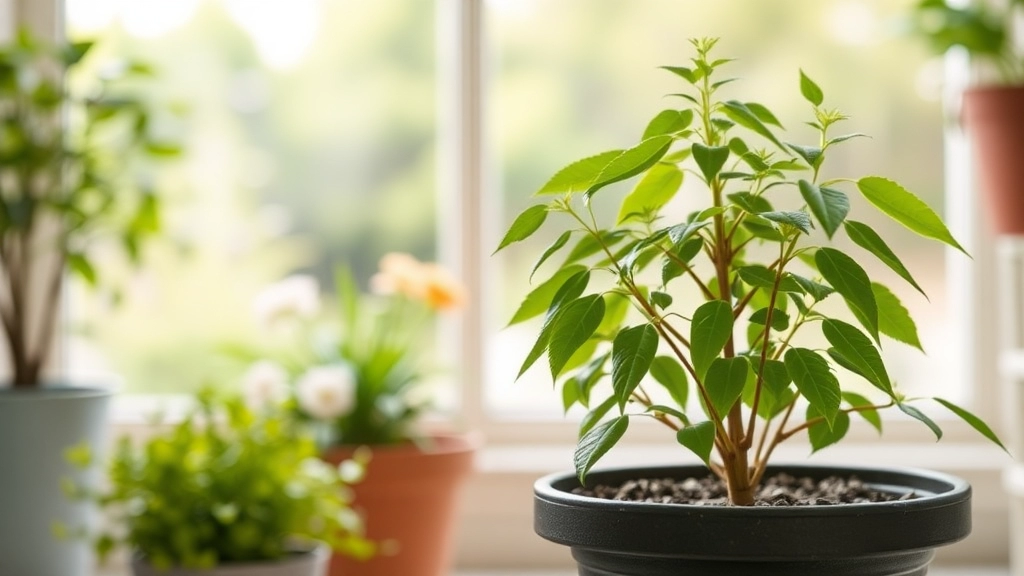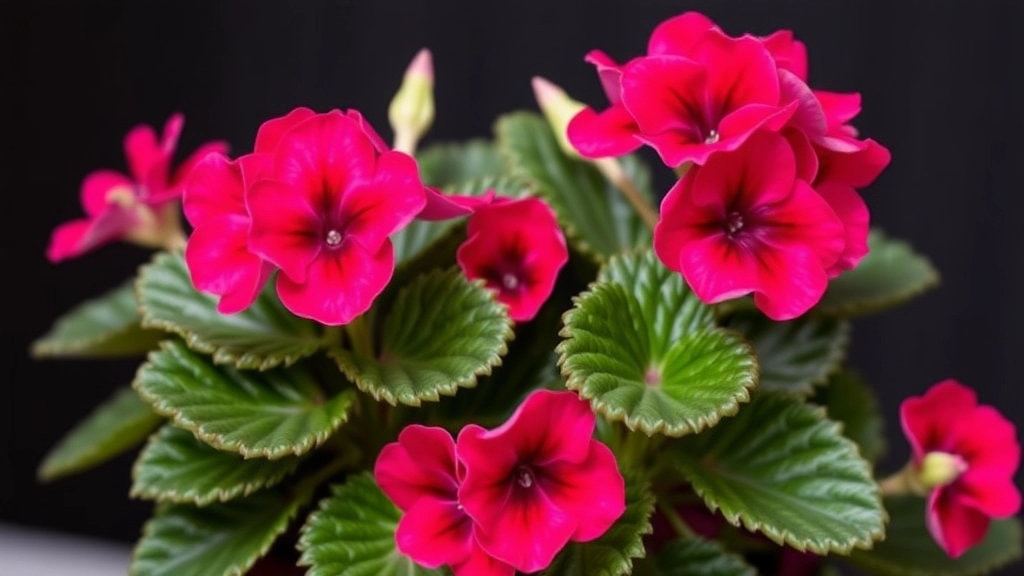Kalanchoe Chocolate Soldier: A Unique Succulent
If you’re a plant enthusiast looking to add a unique and low-maintenance succulent to your collection, the Kalanchoe Chocolate Soldier is a fantastic choice. Known for its fuzzy, brown-edged leaves, this plant not only adds a touch of elegance to your indoor garden but is also relatively easy to care for.
Optimal Growing Conditions
To ensure your Kalanchoe Chocolate Soldier thrives, it’s crucial to understand its optimal growing conditions. This includes the right lighting, watering techniques, and soil types. Additionally, knowing how to manage temperature and humidity, fertilizing needs, and common pests will help keep your plant healthy and vibrant all year round.
Optimal Growing Conditions for Chocolate Soldier
Are you struggling to keep your Kalanchoe Chocolate Soldier thriving?
Understanding the optimal growing conditions is key to nurturing this beautiful succulent.
Light Requirements
First off, light plays a crucial role in the health of your Chocolate Soldier.
- Bright, Indirect Light: Aim for a spot that receives plenty of bright, indirect sunlight. This will help the plant maintain its vibrant colours and compact growth.
- Avoid Direct Sunlight: Too much direct sunlight can scorch the leaves, so be cautious during peak hours.
Watering Practices
Next, let’s talk about watering.
- Soil Drying: Allow the top inch of soil to dry out before watering again. This prevents root rot, a common issue with overwatering.
- Consistent Schedule: During the growing season, water every 1-2 weeks. In winter, reduce this to once every 3-4 weeks.
Soil Type
Now, onto the soil.
- Well-Draining Mix: Use a cactus or succulent mix that drains well. You can also create your own by mixing potting soil with sand or perlite.
- pH Balance: A slightly acidic to neutral pH (around 6.0 to 7.0) is ideal for optimal growth.
Temperature and Humidity
Let’s not forget about temperature and humidity.
Best Lighting Requirements for Kalanchoe Chocolate Soldier

So, you’ve got your Kalanchoe Chocolate Soldier, and now you’re wondering about lighting, right?
It’s a common concern for plant parents. Too much light? Too little? Let’s break it down.
Optimal Light Conditions
Kalanchoe Chocolate Soldier thrives best in bright, indirect sunlight.
Here’s what you need to know:
- Bright but Filtered Light: Place it near a window where it can soak up bright, indirect light. A sheer curtain can help filter the harsh rays.
- Avoid Direct Sunlight: Direct sun can scorch the leaves. If you notice brown spots, it’s a sign it’s getting too much sun.
- Low Light Tolerance: While it prefers bright conditions, it can tolerate lower light levels. Just keep in mind that growth may slow down.
Signs of Happy vs. Unhappy Plants
Keep an eye on your plant’s behaviour:
- Happy Plant: Vibrant, plump leaves and steady growth.
- Unhappy Plant: Stretching towards the light or yellowing leaves? Time to adjust its position!
Seasonal Adjustments
As the seasons change, so does the light:
- Winter: Days are shorter. You might need to move it closer to the window or use a grow light.
- Summer: Ensure it’s not getting too much direct sun as the sun’s intensity increases.
Watering Tips to Prevent Overwatering
When it comes to caring for your Kalanchoe Chocolate Soldier, one of the most common concerns is overwatering. This can lead to root rot and other issues that can jeopardize the health of your plant. Let’s dive into some practical tips to ensure your Chocolate Soldier thrives without drowning.
Recommended Soil Types for Healthy Growth

When it comes to cultivating the Kalanchoe Chocolate Soldier, the right soil can make all the difference. Many plant enthusiasts often wonder about the best soil types for ensuring robust growth and vibrant foliage.
Ideal Soil Composition
For the Kalanchoe Chocolate Soldier, it’s essential to choose a well-draining soil mix. Here are some recommended soil types:
- Cactus Mix: A pre-made cactus soil mix is excellent, as it provides the necessary drainage.
- Succulent Mix: Similar to cactus mixes, succulent mixes are designed for plants that require good drainage.
- DIY Mix: You can create your own by combining:
- 50% potting soil
- 25% perlite
- 25% coarse sand
Key Features of the Soil
- Drainage: Ensure that the soil allows excess water to escape, preventing root rot.
- Aeration: A mix that promotes air circulation is vital for healthy root development.
- pH Level: Aim for a slightly acidic to neutral pH, around 6.0 to 7.0.
Tips for Soil Maintenance
- Repotting: Consider repotting every couple of years to refresh the soil and provide more space for growth.
- Mulching: A light layer of mulch can help retain moisture without suffocating the roots.
Temperature and Humidity Tolerance
When caring for your Kalanchoe Chocolate Soldier, understanding its temperature and humidity preferences is essential for ensuring its health and vibrancy.
Ideal Temperature Range
The Kalanchoe Chocolate Soldier thrives best in a temperature range of 18°C to 24°C (65°F to 75°F).
- Avoid Extreme Cold: Temperatures below 10°C (50°F) can be detrimental.
- Heat Sensitivity: While it can tolerate warmth, avoid exposing it to temperatures above 30°C (86°F) for prolonged periods.
Humidity Preferences
This plant prefers moderate humidity levels.
Fertilizing Needs for Optimal Growth

So, you’ve got your Kalanchoe Chocolate Soldier thriving, but are you giving it the right nutrients?
Fertilizing is key for keeping your plant healthy and vibrant. Here’s what you need to know:
- Frequency: Feed your Chocolate Soldier every 4-6 weeks during the growing season (spring and summer). This is when it’s most active and needs that extra boost.
- Type of Fertilizer: Use a balanced, water-soluble fertilizer. A formula like 10-10-10 or a cactus/succulent mix works wonders.
- Dilution: Always dilute the fertilizer to half the recommended strength. Too much can burn those delicate roots.
- Application: Apply it when you water your plant. This helps distribute the nutrients evenly.
- Winter Care: During the dormant months (fall and winter), cut back on fertilizing. Your Chocolate Soldier won’t need as much, and over-fertilizing can lead to problems.
Just imagine your plant soaking up all those nutrients like a sponge. It’s like giving it a little boost of energy, helping it grow strong and healthy.
Common Pests and How to Treat Them
As we delve deeper into caring for your Kalanchoe Chocolate Soldier, it’s essential to be aware of common pests that may disrupt its growth.
Identifying Common Pests
- Mealybugs: Small, white, cotton-like insects found in leaf joints.
- Spider Mites: Tiny, spider-like pests that create fine webs on the plant.
- Aphids: Small, soft-bodied insects that can be green, black, or brown.
- Scale Insects: Hard, shell-like pests that attach to leaves and stems.
Treatment Options
- Manual Removal: For mealybugs and scale insects, gently wipe them off with a cotton swab dipped in rubbing alcohol.
- Insecticidal Soap: Spray your plant with insecticidal soap to tackle aphids and spider mites. Ensure thorough coverage.
- Neem Oil: A natural remedy that works against various pests. Mix with water and apply as a foliar spray.
- Regular Inspection: Check your plant weekly for any signs of infestation. Early detection is key.
Prevention Tips
- Maintain Airflow: Ensure your plant has good ventilation to prevent pest infestations.
- Quarantine New Plants: Keep new additions away from your existing collection for a few weeks.
- Healthy Plant Care: A well-cared-for plant is less likely to attract pests.
For more detailed guidance on maintaining the health of your Kalanchoe Chocolate Soldier, you can refer to our Kalanchoe Chocolate Soldier Plant Care Guide. Additionally, if you’re facing issues with dying leaves, our article on Causes and Solutions for Dying Kalanchoe Leaves might be helpful.
Seasonal Care: Indoor vs Outdoor Placement

So, you’ve got your Kalanchoe Chocolate Soldier and you’re wondering where it should hang out during different seasons, right?
Indoor vs Outdoor Placement
Indoor Care:
- Winter: Keep it inside. It loves warmth, and your home is perfect.
- Light: Place it near a bright window but avoid direct sunlight, which can scorch those lovely leaves.
- Humidity: Indoor air can be dry in winter, so consider misting it occasionally or using a humidity tray.
Outdoor Care:
- Spring/Summer: This is the time to let it bask outside! Just make sure it’s in a spot with filtered sunlight.
- Temperature: Ensure it’s not exposed to chilly nights. If temperatures drop below 10°C (50°F), bring it back inside.
- Watering: Outdoor plants may need more frequent watering, especially during hot spells. Just keep an eye out for overwatering.
Key Points to Remember:
- Always keep an eye on the weather. Sudden cold snaps can be harmful.
- If you’re transitioning your plant from indoors to outdoors, do it gradually to avoid shock.
Propagation Techniques for Chocolate Soldier
When it comes to expanding your collection of Kalanchoe Chocolate Soldier, propagation is a rewarding and straightforward process. Many plant enthusiasts often wonder how to successfully propagate their plants without causing damage.
Propagation Methods:
- Leaf Cuttings:
- Select a healthy leaf from the parent plant.
- Using a clean, sharp knife, cut the leaf at the base.
- Allow the cut end to dry for a few hours to form a callus.
- Place the callused end in well-draining soil and lightly water.
- Keep the soil moist but not soggy until roots develop.
- Offsets:
- Chocolate Soldier often produces offsets, or “pups,” around its base.
- Gently separate the offset from the parent plant, ensuring it has some roots attached.
- Plant the offset in a pot with suitable soil and water lightly.
- Monitor for new growth, indicating successful propagation.
- Stem Cuttings:
- Choose a healthy stem and cut it just below a leaf node.
- Allow the cutting to dry for a few hours.
- Plant the cutting in soil, ensuring the leaf node is buried.
- Water sparingly until roots form.
Key Tips for Successful Propagation:
- Timing: The best time to propagate is during the growing season, typically in spring or early summer.
- Environment: Ensure a warm, bright location but avoid direct sunlight to prevent scorching.
- Patience: It may take a few weeks for roots to develop, so be patient and keep the soil slightly moist.
By employing these techniques, you can grow multiple Chocolate Soldiers to brighten your space or share with friends. For more detailed guidance on propagation, check out our Kalanchoe Daigremontiana Propagation Guide. Additionally, if you’re interested in learning about other Kalanchoe varieties, our guide to different Kalanchoe species can be a great resource.
Toxicity Concerns for Pets and Humans

So, you’ve got your Kalanchoe Chocolate Soldier thriving, but have you thought about its toxicity?
It’s a common worry among plant lovers.
Is Chocolate Soldier Safe for Pets and Humans?
The good news is, while Kalanchoe Chocolate Soldier is a stunning addition to your home, it does have some toxicity concerns.
Here’s what you need to know:
- For Pets:
- Cats and Dogs: The plant can cause gastrointestinal upset if ingested. Symptoms might include vomiting or diarrhea.
- Signs to Watch For: If your furry friend shows signs of distress, it’s best to consult your vet.
- For Humans:
- Generally, Kalanchoe isn’t highly toxic to humans, but it’s still wise to keep it out of reach, especially from curious kids.
- Ingestion can lead to mild stomach discomfort.
Precautions to Take
- Placement: Keep your Chocolate Soldier on high shelves or in rooms where pets and children don’t roam freely.
- Education: Teach kids about not eating non-food plants. It’s a good habit to instill early on.
What to Do If Ingested
If you suspect that your pet or child has ingested part of the plant:
- For Pets: Contact your vet immediately.
- For Kids: Call Poison Control for guidance.
Pruning and Maintenance Tips for Longevity
As we delve deeper into the care of the Kalanchoe Chocolate Soldier, it’s essential to consider how pruning and maintenance can significantly enhance its longevity and overall health.
Why Pruning Matters
Pruning isn’t just about aesthetics; it’s vital for the plant’s growth and vitality. Regularly trimming away dead or yellowing leaves encourages new growth and helps prevent diseases.
When to Prune
- Timing: The best time to prune your Chocolate Soldier is during its active growing season, typically in spring and early summer.
- Signs to Prune: Look for signs like wilting leaves, leggy growth, or any signs of disease.
How to Prune Effectively
- Tools: Use clean, sharp scissors or pruning shears to make precise cuts.
- Technique:
- Remove dead or damaged leaves at the base.
- Trim back any leggy stems to promote bushier growth.
- Aim for a balanced shape by cutting back uneven areas.
Maintenance Practices
To keep your Kalanchoe Chocolate Soldier thriving, consider these maintenance tips:
- Dusting Leaves: Gently wipe leaves with a damp cloth to remove dust and allow for better light absorption.
- Repotting: Every couple of years, repot in fresh soil to provide nutrients and prevent root crowding.
- Monitoring Watering: Ensure you’re following proper watering techniques to avoid overwatering, which can lead to rot.
For more detailed advice on caring for your Kalanchoe Chocolate Soldier, you can refer to our Kalanchoe Chocolate Soldier Care Guide. Additionally, if you’re interested in exploring other Kalanchoe varieties, check out our guide on Kalanchoe Succulent Varieties and Prices.
Common Problems and How to Troubleshoot
So, you’ve got your Kalanchoe Chocolate Soldier all set up, but things aren’t looking quite right. We’ve all been there, right? Let’s dive into some common issues you might face and how to tackle them.
FAQs on Kalanchoe Chocolate Soldier
What are the best lighting conditions for Kalanchoe Chocolate Soldier?
Kalanchoe Chocolate Soldier thrives in bright, indirect sunlight. Avoid direct sunlight as it can scorch the leaves. It can tolerate lower light levels, but growth may slow down.
How can I tell if my Kalanchoe Chocolate Soldier is happy or unhappy?
A happy plant will have vibrant, plump leaves and steady growth. An unhappy plant may stretch towards the light or have yellowing leaves, indicating a need for position adjustment.
What type of soil is best for Kalanchoe Chocolate Soldier?
Well-draining soil is essential. A cactus or succulent mix works well, or you can create your own mix with 50% potting soil, 25% perlite, and 25% coarse sand.
How often should I fertilize my Kalanchoe Chocolate Soldier?
Fertilize every 4-6 weeks during the growing season (spring and summer) using a balanced, water-soluble fertilizer diluted to half strength. Reduce fertilizing during fall and winter.
Can I keep my Kalanchoe Chocolate Soldier outdoors?
Yes, during spring and summer, it can be placed outdoors in a spot with filtered sunlight. Bring it indoors if temperatures drop below 10°C (50°F) to avoid damage from chilly nights.
Is Kalanchoe Chocolate Soldier toxic to pets and humans?
Yes, it can cause gastrointestinal upset in pets if ingested. While not highly toxic to humans, ingestion can lead to mild stomach discomfort. It’s best to keep it out of reach of pets and children.
What should I do if my pet or child ingests part of the plant?
If a pet ingests the plant, contact your vet immediately. If a child ingests it, call Poison Control for guidance.
References
-
Kalanchoe Care Guide – The Spruce
-
Kalanchoe Chocolate Soldier Care – Gardening Know How
-
Kalanchoe Chocolate Soldier Plant Care Guide – Houseplant 411
